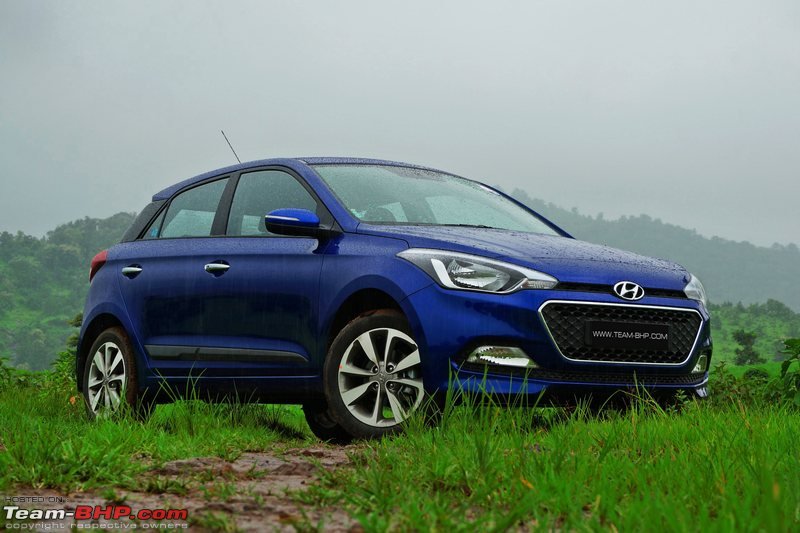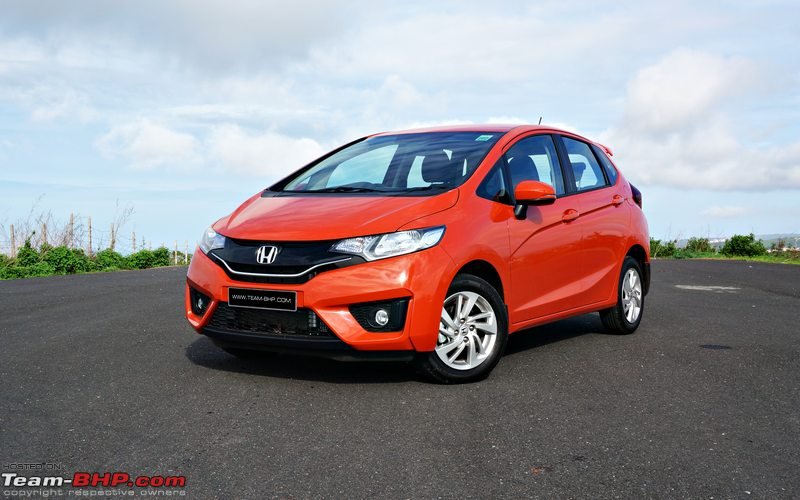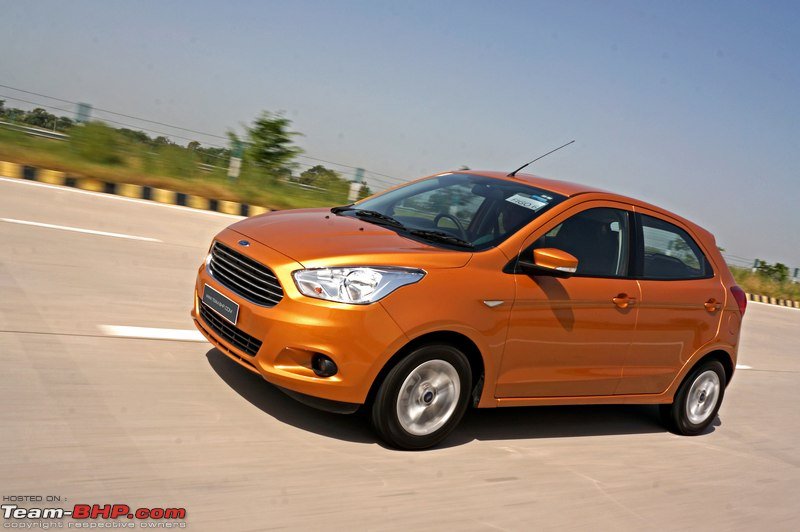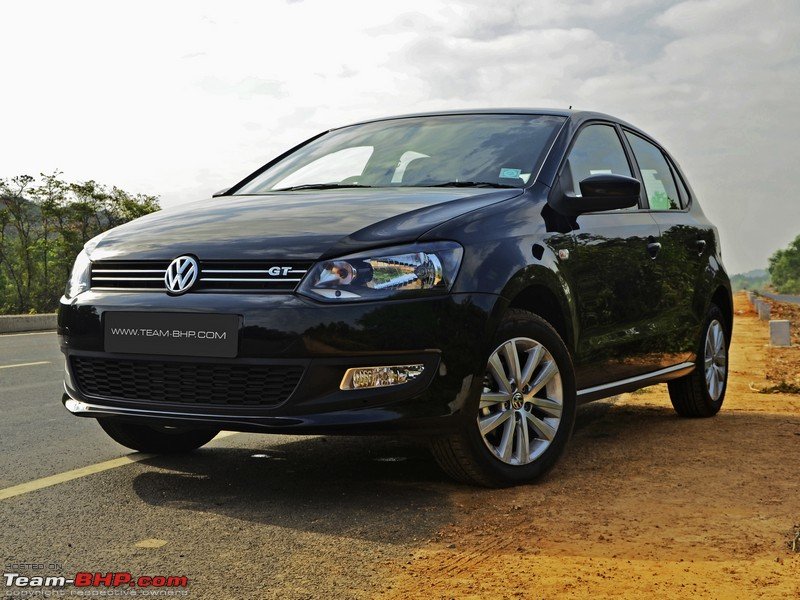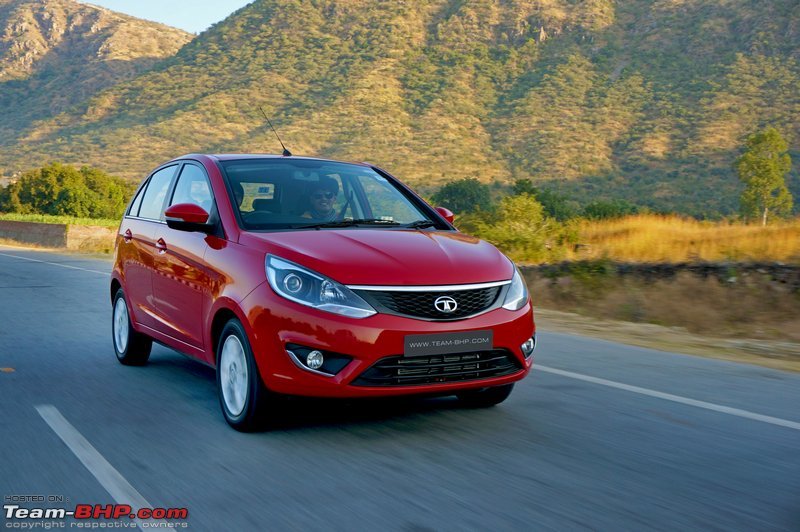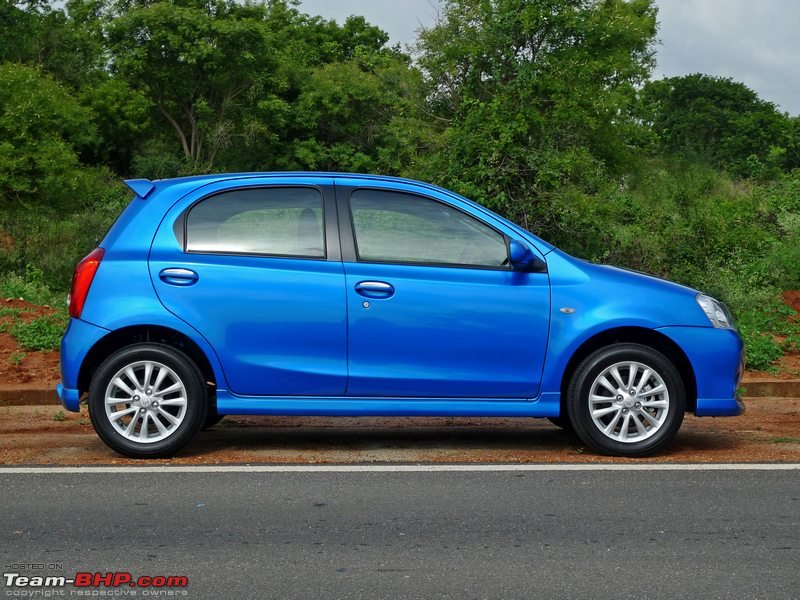| |||||||
| Search Forums |
| Advanced Search |
| Go to Page... |
 |
| Search this Thread |  6,017,774 views |
| | #1 |
| Team-BHP Support  | Maruti Baleno : Official Review The Maruti Baleno has been launched in India at a price of between Rs. 4.99 - 8.11 lakhs (ex-Delhi). What you'll like: • A well-priced, smart looking hatchback • User-friendly cabin with loads of space! Can easily seat 5 tall adults • Accommodating 339 liter boot. The 2nd biggest among hatchbacks (after the Jazz) • Peppy petrol, efficient diesel & smooth automatic - take your pick • Comfortable ride quality matched to neutral handling • Dual Airbags & ABS with EBD are standard across all variants! • Maruti's excellent after-sales service & fuss-free ownership experience • Loaded with features such as UV-cut glass, projector headlamps + DRLs, reversing camera, Apple CarPlay, navigation, electrically-foldable ORVMs and more What you won't: • Ordinary interior quality is Swift-like. Several budget grade parts in here • Rear seat headroom & under-thigh support are limited for tall passengers • Light build quality (weighs merely 865 kilos). Lacks the solidity of its rivals • CVT Automatic suffers from rubber-band effect on the highway • More substantial & premium Elite i20 is priced only Rs. 17,000 - 37,000 above • Waiting period running over 4 months for some variants / cities • Sold exclusively through Nexa outlets. Limits the reach of the car The 2017 Baleno RS: • Link to Review 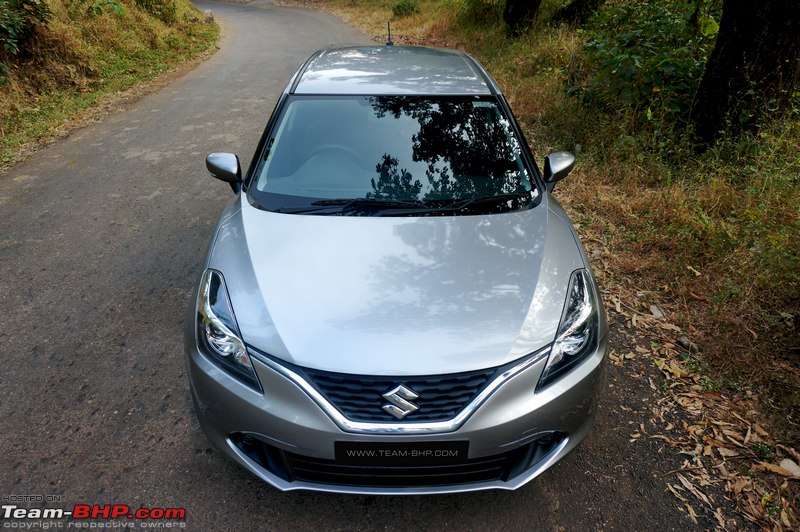 Last edited by GTO : 6th August 2017 at 17:59. Reason: CVT now available in top trim |
| |  (88)
Thanks (88)
Thanks
 |
| The following 88 BHPians Thank Aditya for this useful post: | aah78, Aakarsh, aa_asif, aeroamit, Aficionados, aravindkumarp, carrazy, Chethan B G, chiefpk, dailydriver, darklord, Debashis_1, dkaile, Doge, dr. sen, Dr.AD, dr.fixated, Dr.Q, FGFARahul, frankmehta, Full_Minchingu, fusionbang, gopaneel, Grand Drive, GTO, hybridpetrol, InControl, Jaeger, kannan666, Karthik Chandra, kashyapz8055, Leoshashi, libranof1987, Maky, mayank0782, mbz180, Midas, mmmjgm, mrbaddy, MSAneesh, noopster, NPX, paragsachania, PGNarain, phamilyman, phynix123, Puffdamgcdragon, pulsar56, R2D2, racer_ash, Rajeevraj, rajesh1868, RavenAvi, rednikhil, Researcher, rev_rohit, romeomidhun, S.MJet, S2!!!, samabhi, sandeepmohan, satanic_dude, Scarlet_Rider, shancz, shipnil, shreyak_ss, sidhu_hs, Simhi, snaseer, SnS_12, ssambyal1980, Stratos, suhaas307, sumitsinha0280, swiftnfurious, TaureanBull, theexperthand, Tushar, uday.ere, vb-saan, VeluM, Vid6639, Viju, vikred, vishal21, viv_cal, Waspune, Wildy |
| |
| | #2 |
| Team-BHP Support  |  The old versus the new Baleno. Other than the name, they have nothing in common, not even their body style. Maruti will be pleased with one differentiator though - if the initial 40,000 bookings are anything to go by, the 2015 Baleno is a strong seller! Last month, Maruti shipped out a whopping 9,000 Balenos. We were always wondering where the new Baleno would fit in. If you see the pre-launch discussions, there was scepticism as we expected it to be priced higher. Then, Maruti pulled off a coup by pricing it closer than expected to the Swift. The Baleno's positioning became clear right then. If you like the Swift, but want something bigger, the Baleno is for you. While the Swift is still a competent hatchback selling over 17,000 units each month, those looking for more cabin space, better quality and a more upmarket feel were forced to look outside of a Maruti showroom. With the introduction of the Baleno, Maruti has given its customers an option to upgrade to a product from its own stable. Because Nexa dealerships need to cover their investment, the company has decided to sell it through that premium dealership network. That's in conflict with brand Nexa's positioning as the Baleno isn't a 'truly premium' car. The smaller Nexa network will also limit the reach of the car across India. We find it to be a flawed strategy. 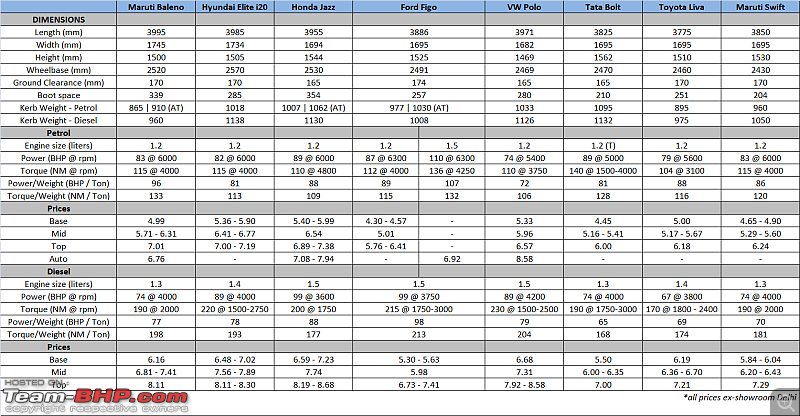 Baleno means 'flash of lightning' in Italian. I found it a little surprising that Maruti used this name for their new car. When one hears the word 'Baleno', the first image that comes up is that of a flopped sedan. I'd have thought of reviving the 'Esteem' nameplate to use on this car. The Esteem, as we know, was immensely popular in India and can instantly connect with our hearts & minds. India is the most important market for Suzuki and hence, the car makes its global debut here. The Baleno will be manufactured at the company's Manesar plant and exported to over 100 countries. The Baleno is built on a lighter "new generation platform". The fact that it is a whopping 95 kilos lighter than the Swift raised a lot of eyebrows...remember, the Swift is a light car to begin with! Get this, even though the Baleno is the longest & widest car in its class, it is also the lightest at merely 865 kgs. To put things in perspective, the Elite i20 petrol weighs 1,018 kilos! Maruti insists that the use of hi-tensile steel makes it 10% stronger than its conventional platform. We hope there is no compromise on safety, but cannot comment further unless it is crash-tested by an independent authority. Important to note that all variants get dual airbags and ABS. The Baleno follows Maruti's "Liquid Flow" design language. Its body is curvy all over with no sharp edges. I found it rather conservative & feel that the Baleno lacks the flair of the Elite i20. Still, it does look contemporary and many will like the styling. Thanks to its dimensions, the Baleno has got good presence too. The front end looks like an evolution of the Swift's. It has large sweptback HID projector headlamps with LED daytime running lights. In the middle is a V-shaped honeycomb mesh grille with a chrome strip running along its lower edge. This strip appears to extend into the headlamps, running towards the side of the car. Since the grille is V-shaped, there are blank areas on either side. A larger grille could make it more interesting, but admittedly more Swift-like. The simple bumper houses a large black air dam with round foglamps. Viewed from the side, the Baleno looks bulbous. It has blackened A pillars (like the Swift), a window line that rises towards the rear and a character line running along the lower portion of the doors. The ORVMs are body-coloured and have integrated turn-indicators. The door handles are finished in chrome, while the ones at the front come with request sensors (for keyless entry). The top-of-the-line Alpha variant rides on 16" alloy wheels that fill the wheel arches very well. The rim design is different from the regular stuff we see, but there is no doubt they look like wheel caps. The 170 mm of ground clearance is at par with most of the cars in this segment. The rear is very chic! Its derrière is certainly more attractive than the face. The rear windscreen is sharply raked and the hatch wears nice curves. There is a thick chrome strip that underlines the windshield - a unique placement. The reverse camera is housed on this strip. The car comes with wraparound LED tail-lamps that stylishly bulge out. The tailgate has an integrated spoiler too. The rear bumper has thin rectangular reflectors at the bottom. It also houses the parking sensors and has a cut out in the middle to enable one to lift the hatch. A radio antenna sits on the roof towards the rear of the car. There is no Maruti badge anywhere on the outside and the only logo you'll find is that of Suzuki. A Baleno badge sits on the left of the hatch. Nope, no badges to show the trim level or transmission either, although the diesel gets DDiS badges on its front panels. The Baleno is a light car and there's no escaping it. Sure, the front doors feel alright and close with a 'thunk' (not thud), but the rear doors are really light. If you are coming from a European car, tap on some body panels and you'll walk away in the other direction. That said, some areas like the tail-gate feel substantial enough, though they are few and far between. Maruti needs to work on its build quality too. Almost every dealership test-drive Baleno out there has rattles emanating from the rear of the car. 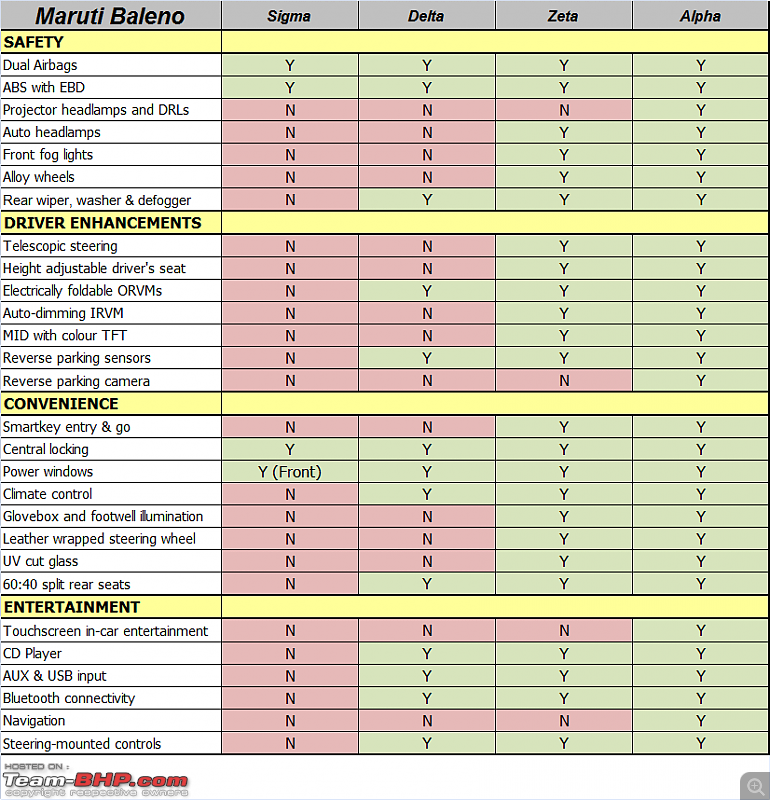 Unusually styled front-end makes for the least appealing view of the car. The V-shaped radiator grille is weirdly designed with large gaps on either side! We think this was intentional...to differentiate it from the Swift. With a conventional grille, the two would look too similar:  Chic looking rear with a sharply raked windscreen, bulging out tail-lamps and a fat, uniquely positioned chrome strip:  The tinted effect from the UV-Cut glass looks swell. Viewed from the side, the Baleno has a bulbous look. Maruti's liquid flow design means it's all curvy, no sharp lines here. Wheel arches are very prominent:  Blackened A-Pillar, just like the Swift. Baleno doesn't turn heads like a new product usually does. It blends in with the crowd & doesn't stand out: 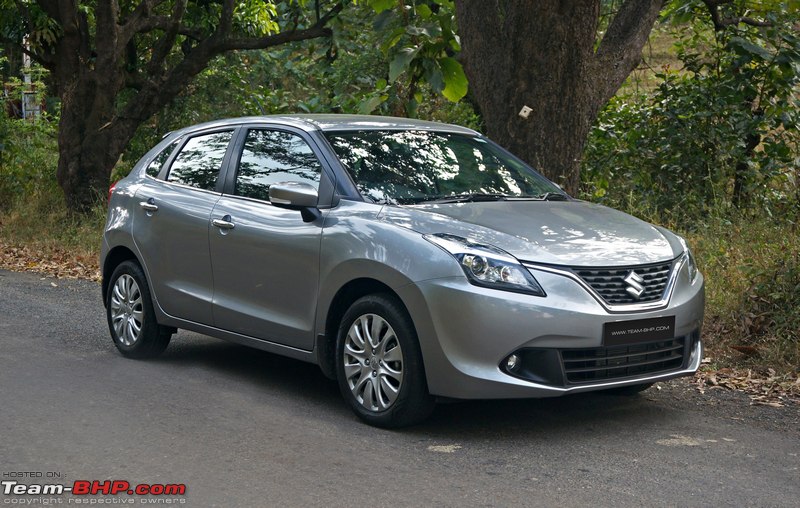 One of the best angles to view the Baleno from. In fact, the Baleno looks prettier than the more expensive car that it shares showroom space with (i.e. the S-Cross): 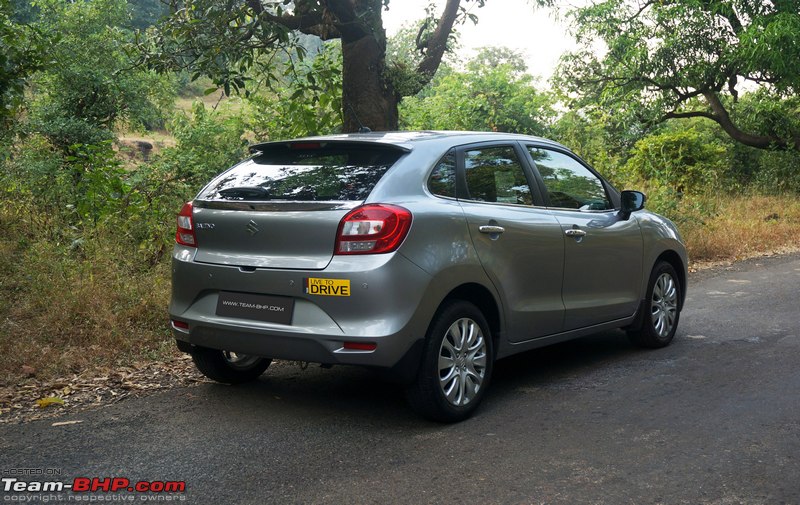 Swift-like headlamps with bi-xenon projectors & LED DRLs. See how the radiator grille's chrome strip extends into the headlamps:  With the projector & DRL in action:  Bright DRLs are always on, even during the day. Front grille is awkwardly shaped. Bumper has a simple design & layout:  Shockingly, no underbody protection at all! Not even a plastic cover below the engine. This is unacceptable for Indian road conditions - Maruti should know better: 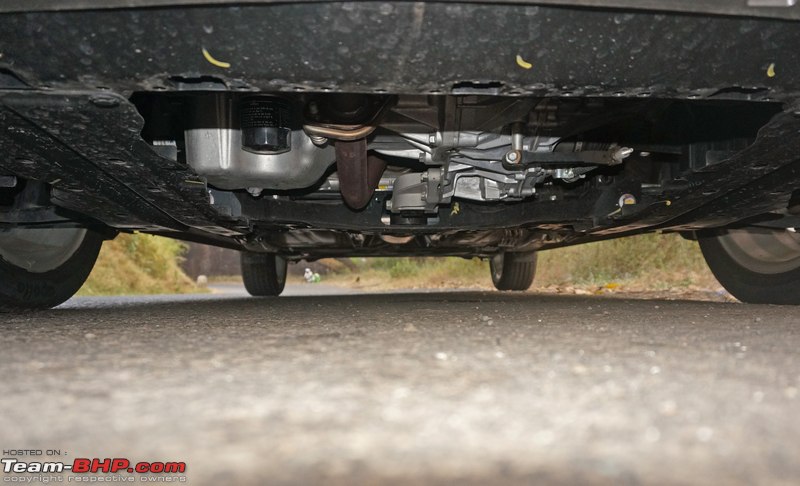 A pair of tri-nozzle washers spray enough water to clean the windscreen:  16" rims with 195/55 section Apollo Alnac 4G tyres give the Baleno a nice stance. A rare Maruti hatchback that isn't under-tyred. Opinions will be divided on this alloy wheel design - looks like a wheel cap for sure. Some did find it classy though. Lesser variants are equipped with 185/65 R15 tyres:  Small flaps ahead of the rear wheels too. Purpose = aerodynamics: 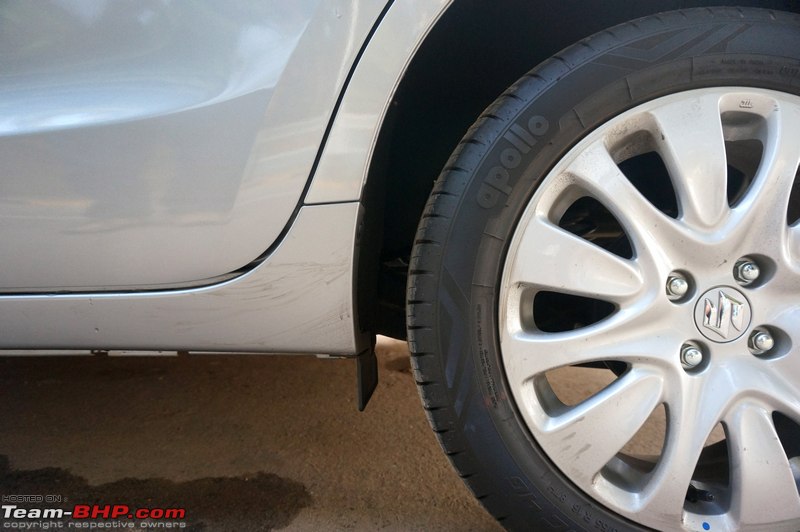 Both wheel wells get cladding on the inside:  Chrome door handles. Request sensors on both sides, but keyhole only on the driver's: 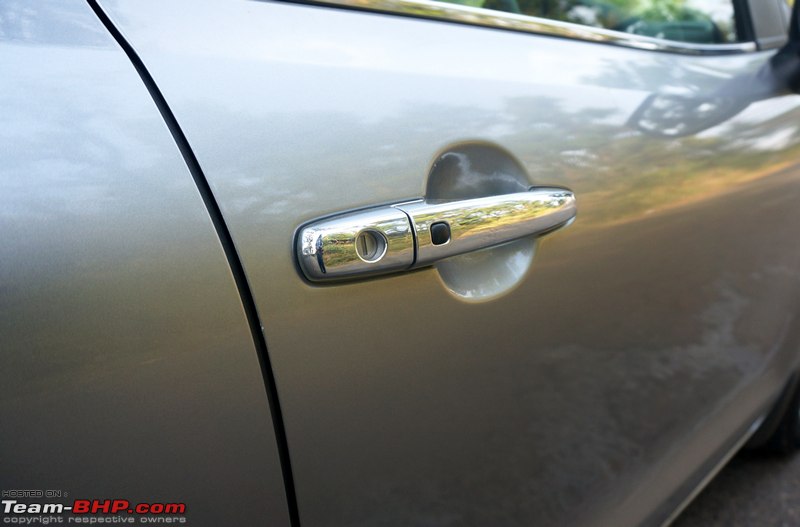 ORVMs mounted on the door, just like its bigger sibling, the S-Cross:  Sharply angled C-Pillar & sloping roof look great, but they chew away rear headroom. Window line rises toward the rear, which means the glass area isn't large. Don't miss the subtle chrome strip running along the window line:  Short, stubby roof antenna - shared with the Swift - sits toward the rear:  Like the Honda Jazz, the Baleno has its rear quarter glass on the C-Pillar. Brings that much more light inside:  LED tail-lamp cluster. Lower variants get a slightly different unit (image link). The 2nd (lower) strip is a dummy:  With the LEDs in action: 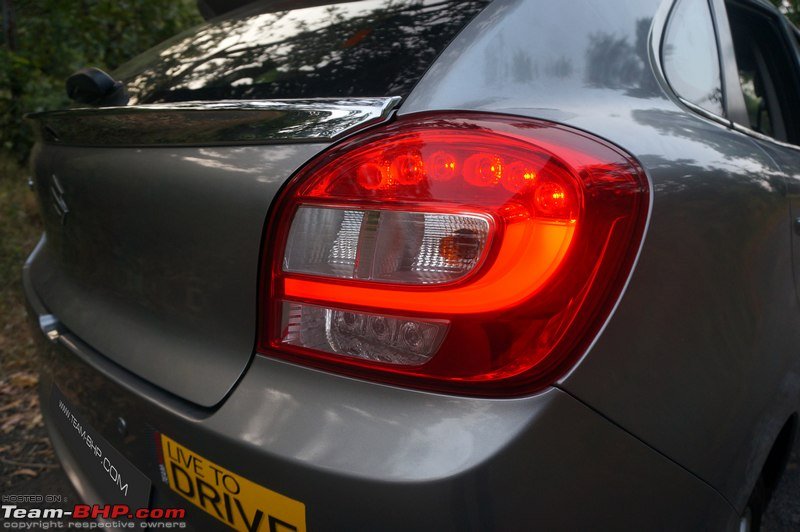 Reversing camera is sweetly integrated into the chrome garnish:  Just like at the front, the rear bumper also has a simple design. 4 parking sensors with a pair of reflectors at the bottom:  The "Baleno" badge has almost the same font & style as the original (link to image):  170 mm of ground clearance. However, the rear end sags considerably with passengers on the back seat. We'll leave the final verdict on the real-world clearance to our ownership reports. Fuel tank capacity = 37 liters. That's even smaller than the Swift (42 liters)!  Shut lines are at par with others in the segment. Very tight in some places and...  ...wider & less consistent around the bonnet:  The Baleno is exactly as long as the Dzire and is a superior car too. We can't think of any reason to pick the Dzire over the Baleno:  Side by side with the Elite i20:  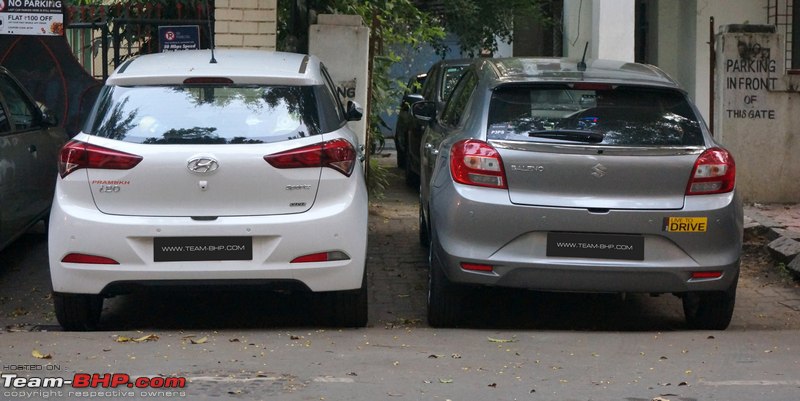 In red. Also available in a nice blue (link to image) which appears to be a favourite with BHPians. In this pic, notice the DDiS badge on the front panels. Other than this, there's no way to tell the diesel apart from the petrol: 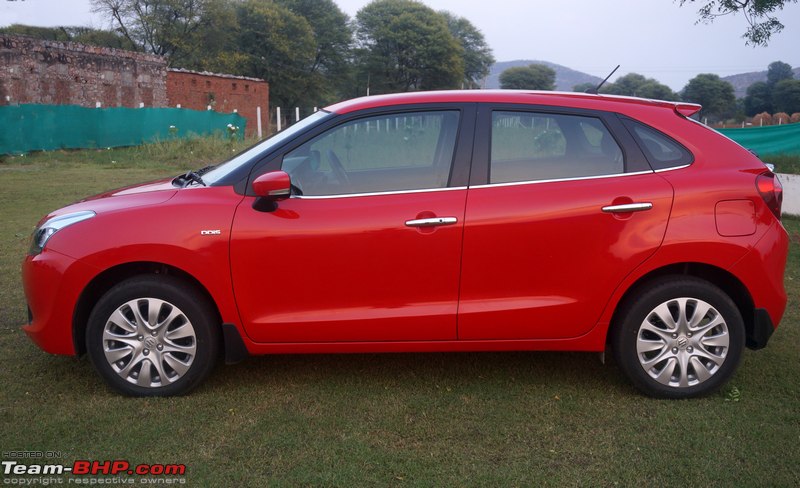 Last edited by GTO : 5th April 2016 at 11:14. Reason: flash of lightning |
| |  (81)
Thanks (81)
Thanks
 |
| The following 81 BHPians Thank Aditya for this useful post: | aah78, abhik897, abhishekd, Added_flavor, aeroamit, ashishk29, ashpalio, baby_antu, BlackPearl, carrazy, Contrapunto, darklord, dkaile, Doge, dr. sen, Dr.AD, Dr.Q, FGFARahul, fulcrum.xyz, fusionbang, gopaneel, gschandra, GTO, iabhishekkumar, InControl, kannan666, Karthik Chandra, kashyapz8055, KLxpress, landcruiser123, Leoshashi, libranof1987, LordSharan, Maky, Midas, Mithrandir, motorpsycho, mrbaddy, MSAneesh, noopster, PGNarain, phynix123, R2D2, racer_ash, Rajeevraj, rajesh1868, RavenAvi, rednikhil, Researcher, rev_rohit, romeomidhun, rshanker, S.MJet, S2!!!, samabhi, satanic_dude, Scarlet_Rider, shancz, sidhu_hs, sidrn, Simhi, srishere, ssambyal1980, suhaas307, sumitsinha0280, swiftnfurious, Technocrat, theexperthand, Tushar, uday.ere, valapad, vb-saan, vibbs, Vid6639, VijayAnand1, Viju, Vik0728, vikred, viv_cal, vredesbyrd, Wildy |
| | #3 |
| Team-BHP Support  | Interior - Front The Baleno is equipped with a keyless entry & go system, which means you don't have to take out the key to unlock the door or start the car. As long as the smartkey is in your pocket, press the request sensor located on the door handle to enter. Request sensors have been provided on both front doors. The front doors open wide with a 3-stage action and, as the car is not too low, ingress and egress aren't troublesome. Once inside, you'll notice that the interiors are very spacious (unlike the Swift). No beige here - the cabin is black coloured. Some will like it, others will miss beige. The silver inserts look tasteful, and the upper half of the cabin (pillars, roof lining, sunvisors and IRMV) is in beige. While the overall quality is acceptable, it's certainly not in the league of the Elite i20 which remains the benchmark. Take a close look at the interior plastics and you'll find several budget-grade areas. The cabin is full of hard plastics. The door panels feel very flimsy, and they flex so easily! Part quality is comparable to a Swift, and not the premium hatchbacks in the market. That said, no rough edges or ill-fitted parts anywhere. There are some neat touches too. The cabin has ambient lighting - the footwells are illuminated by a red glow when the parking lights are switched on. Both the sunvisors are equipped with ticket holders and illuminated vanity mirrors. If you put your hand behind the glovebox, you'll find that it is padded to prevent rattling. The dashboard's design is straightforward and user-friendly. It is contemporary enough. All controls are pretty much where you'd expect them to be, easy to reach and to operate. The 3-spoke steering wheel is a straight lift from the Ciaz. While it doesn't have thumb contours, it still feels nice to hold. The steering is a leather-wrapped unit with chrome inserts and integrated buttons for audio & telephony. The steering can be adjusted for height as well as reach. Any fault? Yes, operating the hornpad requires you to stretch your thumb. The wiper and light stalks are well placed making them easy to operate. The gear lever isn't too far from the wheel, which means your left hand needs to travel that much lesser between the two. The gear knob is lifted from the Ciaz as well. The front seats have sufficient padding & just the right amount of firmness (not too soft, nor too hard). The neck restraints are firm, but not rock hard. Must comment that the upholstery quality itself feels economy-grade. The driver's seat gets height adjustment and, with the steering wheel's four-way adjustability, it doesn't take long to find a comfortable driving position. You'll be at home in 2 minutes. The seatbelts are height-adjustable too. The ABC pedals are logically placed and properly spaced out. The raised dead pedal is usable as well. At 5'10", I had no problems with the headroom. What isn't cool is the placement of the center armrest. It is located ~10 cm behind than where it should have been. This makes it useless for most drivers. Frontal visibility is good due to the low-placed dashboard. While the A pillars are thick, they don't hamper visibility as some other cars we know. The ORVMs are well placed and owners will appreciate their 'electric fold' feature. They are attractively styled, but I would have liked them to be wider. They are a size too narrow. The IRVM has an auto-dimming function. Rearward visibility is rather poor as the glass area is limited. The thick C pillars and big rear headrests further reduce the view out back. We must add that blind spots are created by the thick C pillars even while you're driving, so be careful of a biker or the like hidden behind. The instrument cluster is all-new with the tachometer on the left, a 4.2" colour TFT MID in the middle and the speedometer on the right. Happy to see a temperature gauge here. The two dials have white fonts with blue circles running on the inside. They look super cool! The MID offers the usual data: real-time & average fuel economy, distance to empty counter, temperature & time etc. Uniquely, it also shows you the power & torque being used (pictures below). Various settings (security, lights etc.) can be tuned via the MID. The 'SmartPlay' infotainment head-unit is the same one seen in the S-Cross & Ciaz. It has a 7" touchscreen with USB, AUX, SD card and Bluetooth connectivity. The touchscreen is easy to read and there are no issues with light or reflections. A new addition is Apple CarPlay that allows the owner to use his iPhone via the touchscreen display & Siri voice command system. You need to connect your iPhone via a USB cable to integrate it with the car. Android Auto? It's in the pipeline and should be here in 2016. The touchscreen doubles up as a reversing camera and navigation system. Navigation is via pre-loaded maps on an SD card. Sound is channelled through 6 speakers. Each door houses a speaker and the ones at the front get a tweeter each. Compared to what we saw in the initial lot of Ciaz', Maruti appears to have made improvements to the head-unit's software. The touchscreen is responsive and suffers very little lag, if at all. While we're on the head-unit, must add that the glossy black area around the touchscreen is the only fingerprint magnet in this car. Sitting below the infotainment system is the hazard light switch. There is a big blank panel next to it which gives one a feeling that some feature is missing. Below these two buttons is the climate control. The circular climate control display has white, easy-to-read fonts. I found the Baleno's air-con to be very effective. It cooled the cabin competently even when it was extremely hot outside (sadly, it still feels like summer in Bombay!). Trivia = the erstwhile Baleno sedan was said to have the most powerful air-conditioner in its class, and one or two above. In terms of storage, all four doors are designed to hold 1-liter water bottles. The front doors also get well-sized storage pockets. The glovebox is on the smaller side - it is illuminated by a red light when the parking lights are switched on. Ahead of the gearlever is a squarish compartment with a removable plastic partition. You can use this partition to keep things divided, or remove it when there's a larger object to place. Right above are the 12V power outlet, USB and AUX ports. There is a shallow area below the handbrake to keep your smartphone. Additionally, the driver's armrest has a storage bin underneath. Cabin is black with a beige top half (pillars & up). Dashboard is straight-forward & contemporary: 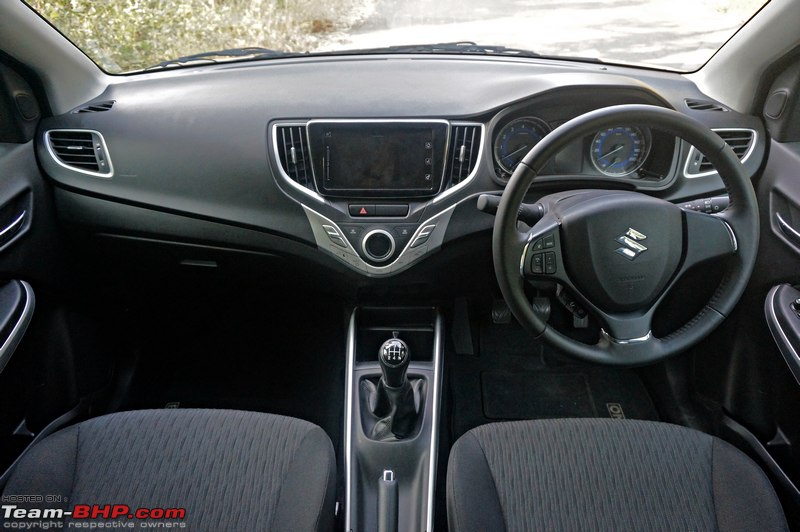 Black steering wheel with chrome inserts is borrowed from the Ciaz. It doesn't have thumb contours, yet is nice to hold. Horn pad can be a stretch for your thumbs; those with small hands will need to take one off the wheel to honk: 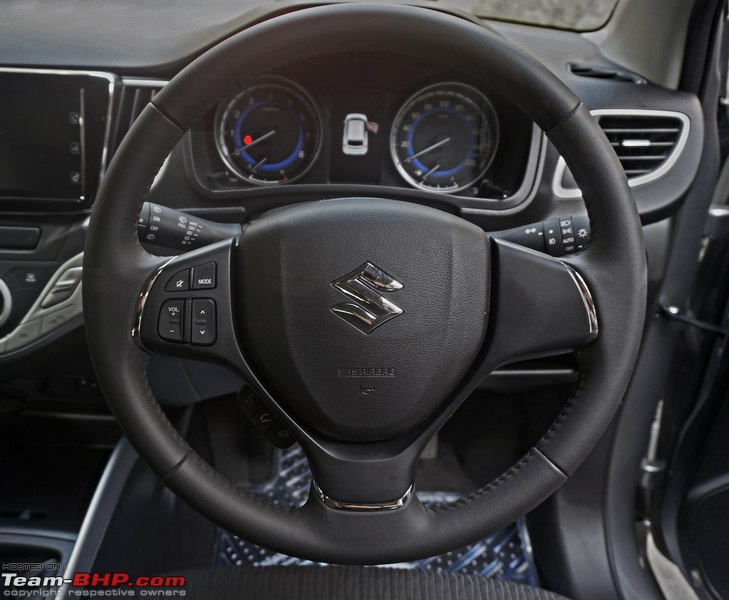 Buttons for controlling the audio system are large and easy to use. Mute button is practical:  Pull-type telephony controls have a unique location behind. Some will like it, some won't:  The steering can be adjusted for height as well as reach  : : Good looking instrument cluster with white fonts & blue circles. It's easy to read. Nice to have an analogue temperature gauge. Petrol's revv counter is marked till 8,000, but it revs to 'merely' ~6,300 rpm!  MID readouts before starting the engine and after switching it off. While the system recommends that you press the brake pedal, it actually requires only the clutch to be pressed. If you press the start button without the clutch, the car enters 'accessory' mode (with an MID prompt). In accessory mode, you can operate the stereo. After switching the car off, you get a summary of your drive with range:  MID readouts for the clock (with numbers & arms!), date, outside temperature, two trip meters, power and torque usage and the reverse parking sensor display. The power & torque graphical displays are gimmicky; fun to use initially. They show you how much torque & power you are using (of what's available). As an example, start driving and you'll see the torque rising more than the BHP:  1st display is showing the average fuel economy & distance to empty. 2nd display shows the fuel economy over 5 / 10 / 15 minutes. Last display shows the average speed (5 / 10 minutes) along with the driving time:  Usual bunch of settings in the MID. Ignore 'set sensors' ('trailer mode' for parking sensors):  MID has a gearshift indicator that suggests upshifts & downshifts. It also displays a dot when you are in the right gear:  Ugh - like the Honda City, you use this stalk to scroll through the MID. A dedicated button would have been preferred. The stalk doesn't feel robust either:  The engine start button is placed on the right side of the steering wheel. Odd, most cars have it on the left. The 'disable parking sensor' button and headlight leveller sit below. If you disable the parking sensors, even the parking display on the MID disappears, but the camera still works (rightly so). Foglamp control has been moved to the light stalk:  Wiper and light stalks are chunky. Yep, the Baleno gets auto headlamps:  A look at the center console. See how the gear console is angled towards the driver:  Infotainment system (covered in detail later) with vertical air-con vents on both sides. Don't miss the classy chrome border around the head-unit. Hazard light button & a dummy panel below:  Buttons to operate the climate control are adequately sized. The display has white fonts and is easy to read:  Front seats provide good support. Side bolstering is healthy. Tall & narrow headrests look weird...as weird as the jelly bean Zen's headrests (link to image)!  Front seat has a healthy travel range. The full-back position...  ...and full-forward: 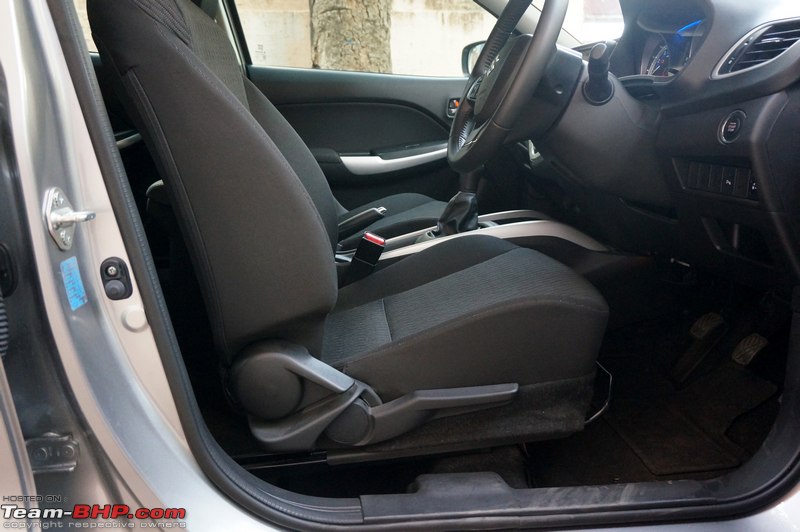 Driver's seat has height-adjustment. This lever doesn't feel durable - very flimsy: 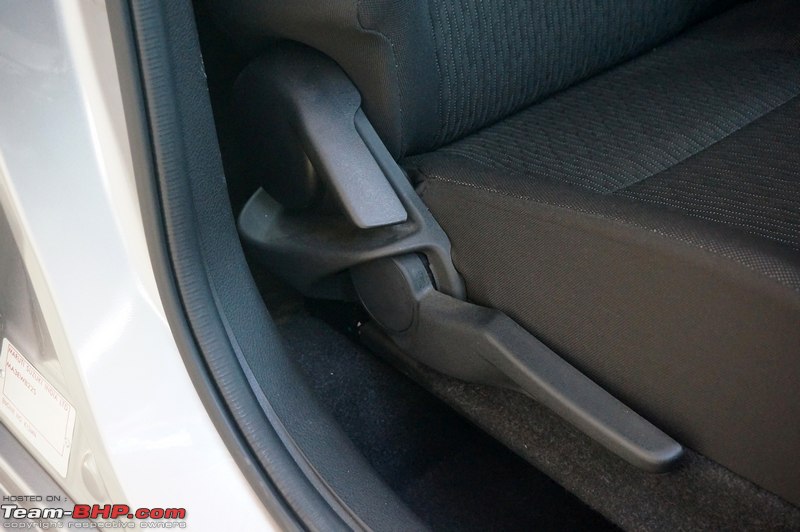 Useless center armrest is located too far back:  It has a storage bin underneath:  Front doors open with a three-stage action. Doorpads house a speaker + tweeter (on top). 1 liter bottle holder with a well-sized door pocket. Door handle is finished in shiny chrome. Doorpad gets a fabric insert (including the area where your elbow rests):  Standard Maruti console that you've been seeing since a decade. Driver's window gets one-touch up and anti-pinch functionality. Door mirrors are electrically foldable. Nope, the buttons aren't illuminated: 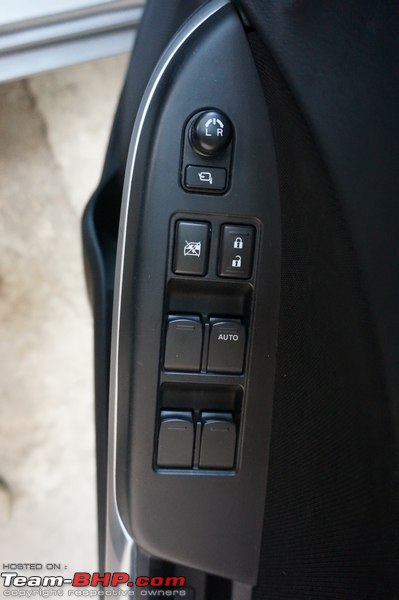 ORVMs should have been wider. i20's design & width are preferred (link to image):  Pedals are well-spaced out. Dead pedal is usable:  Front seatbelts are adjustable for height:  There is a shallow space below the handbrake to place your smartphone:  12V power socket and USB + AUX ports are located ahead of the gear lever. Center console gets a squarish storage cubicle with a removable partition:  The glovebox is on the smaller side. It's illuminated, but not cooled:  Both sunvisors get ticket holders and illuminated vanity mirrors:  Passenger's sunvisor gets an airbag warning on the front & back! No babies on this seat   Twin reading lamps at the front. The cluster also houses the Bluetooth mic:  As you can see, rearward visibility is limited in the Baleno: 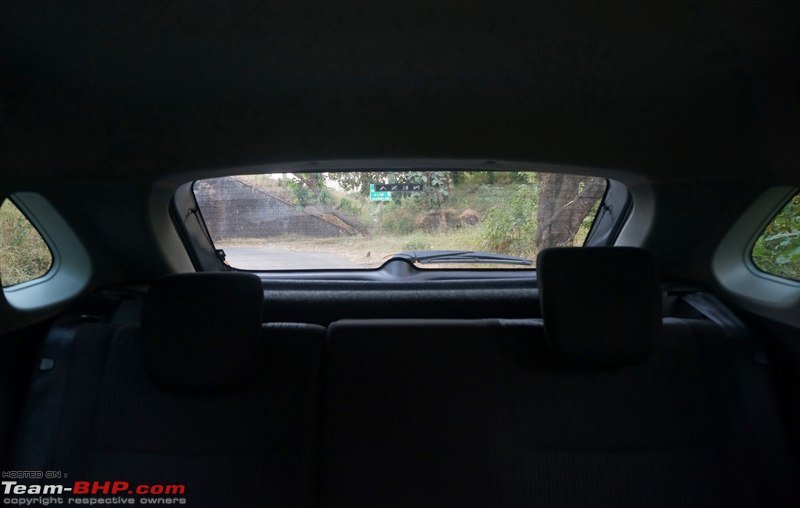 Last edited by GTO : 9th December 2015 at 18:10. |
| |  (59)
Thanks (59)
Thanks
 |
| The following 59 BHPians Thank Aditya for this useful post: | aah78, abhik897, ACMohan, aeroamit, Aficionados, ashpalio, carrazy, Contrapunto, dkaile, Dr.AD, Dr.Q, fulcrum.xyz, GTO, hiren.mistry, InControl, Karthik Chandra, kashyapz8055, KLxpress, libranof1987, LordSharan, Maky, Midas, Motor_Nut, mrbaddy, MSAneesh, noopster, petrolhead_neel, PGNarain, phynix123, R2D2, racer_ash, rajesh1868, RavenAvi, rednikhil, Researcher, rev_rohit, romeomidhun, rshanker, S.MJet, S2!!!, SaiSW, samabhi, satanic_dude, Scarlet_Rider, shancz, sidhu_hs, Simhi, Technocrat, theexperthand, Tushar, uday.ere, vaasu, valapad, vb-saan, vibbs, Vid6639, vikred, viv_cal, Wildy |
| | #4 |
| Team-BHP Support  | Interior - Rear The Baleno's rear doors open with a 2-stage action. They open wide enough and getting in isn't difficult, though the elderly will find the rear seat to be placed low. Once again, the space will impress you. Tall adults will easily be accommodated on the rear seat. Even with the front seat pushed all the way back, there is sufficient legroom at the rear. At 5'10", I had ~3 inches of knee room in this position! With the seat in my own driving position, the knee room doubled. The rear seat is wide enough to accommodate three passengers. The floor hump is about 3 inches high, but not too wide. While it isn't intrusive, the middle passenger will be happiest to place his feet on either side of it. While the rear seat is wide and fairly well padded, tall passengers will wish it was placed a level higher. Tall occupants will sit in a somewhat knees-up position - this can affect the under-thigh support for them. It is also f-l-a-t with no contours to speak of. The seat gets two properly sized adjustable neck restraints and is 60:40 split-folding, but there is no center armrest. Headroom is just about enough at the rear. I had two inches to spare at best. Anyone over 6 feet tall is likely to brush his hair / head against the roof. This is probably why Maruti didn't place that rear bench any higher. Due to the rising window line, short passengers will have their outside view obstructed, while those large front seat headrests block your view of the road ahead. The doorpads house 1-liter bottle holders. The front passenger's seat gets a seatback pocket which can be used for storage. A 12v power socket for charging your smartphone has been provided and the right-side grab handle sports a coat hook. However, there's no rear air vent here like in the Elite i20. Considering the powerful air-con, we doubt anyone will be complaining though. You can access the boot without removing the smartkey from your pocket. Simply press the request sensor (placed on the underside) to unlock, and then press the release button that is located next to it. The Baleno has one of the biggest boots among hatchbacks. At 339 litres, it is only second to the Honda Jazz (354 litres)! Even though the suspension takes up some space, it has enough room to accommodate medium-sized suitcases. Boot space can be increased considerably by folding the rear seat down. On the flip side, its mouth is not as wide as the Elite i20's. Reason? The tail lights are fixed one-piece units rather than the split units of the Hyundai. Additionally, the boot sill is rather high. A Maruti engineer told me they had to make it so because of the European legislation on bumper height. Rear doors open in a dual-stage action. Doorpads have 1 liter bottle holders & fabric inserts for your forearms. Black colour means less cleaning:  Long wheelbase = impressive rear legroom. Tall adults? No sweat:  On the right is me sitting behind a 5'10" driver. Ample legroom:  Rear bench is wide enough for 3 occupants. Big headrests are adjustable. No center armrest provided however. Seat is flat with no contours to speak of:  Tall occupants will find the rear seat to be a level too low and this can take away under-thigh support for them. Maruti couldn't raise it though - look at the headroom (I'm 5'10"). 6 footers will brush their head against the roof: 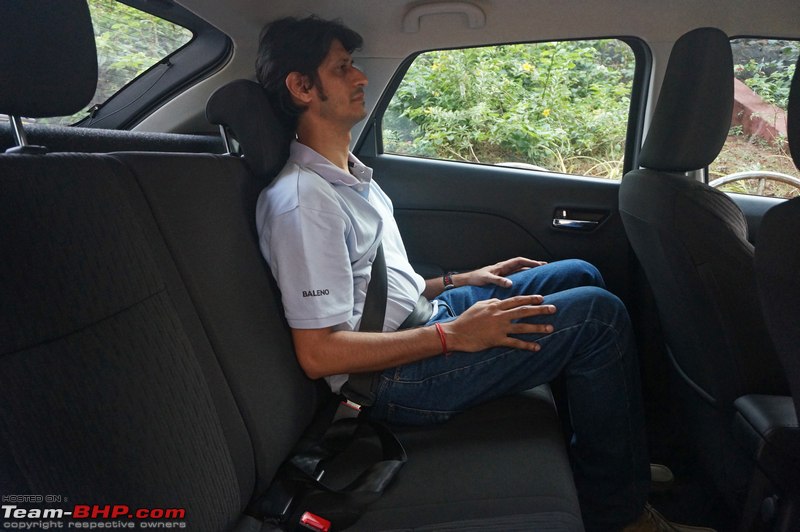 A closer look at the limited headroom & big adjustable neck restraints: 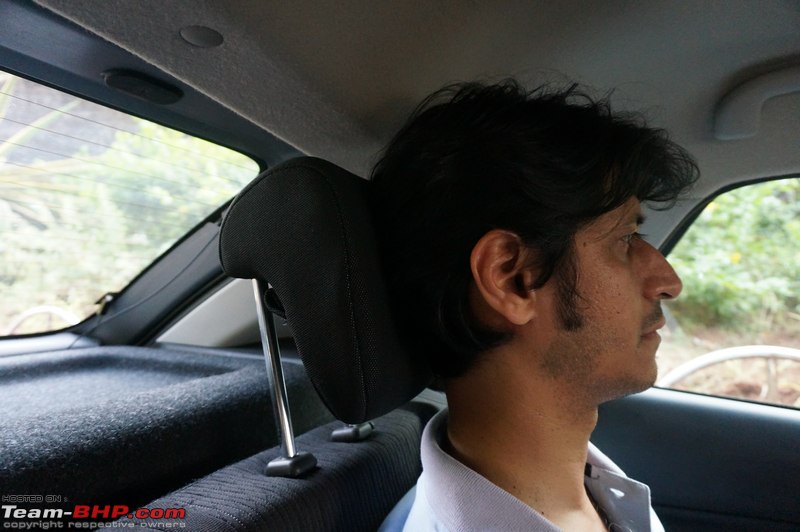 Floor hump is about 3 inches high and not too intrusive. Still, the middle passenger will want to place his feet on either side of it:  No air-conditioner vent at the rear (Elite i20 has it), but there is a 12V power socket to charge your smartphone. Don't miss the small storage cubicle below: 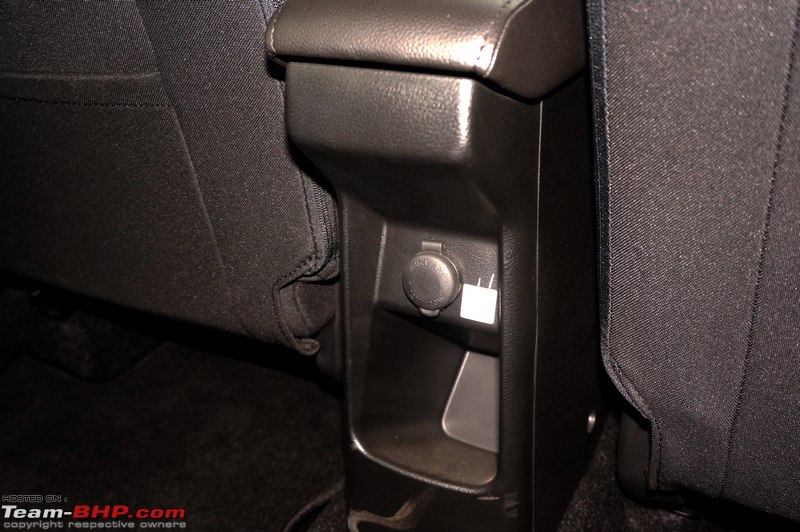 Simple cabin light is shared with other Marutis. It is located between the front & rear seats:  Front passenger's seat gets a seatback pocket. Very useful:  Rear window can be rolled down all the way...well, almost:  Spring-loaded grab handles have a damped action. Only the rear-right unit gets a coat hook:  Boot space is a whopping 339 liters, second only to the Jazz! The mouth isn't as wide as the Elite i20's, thanks to the fixed one-piece tail lamps. Loading lip is high too, so you will need to 'lift up' luggage: 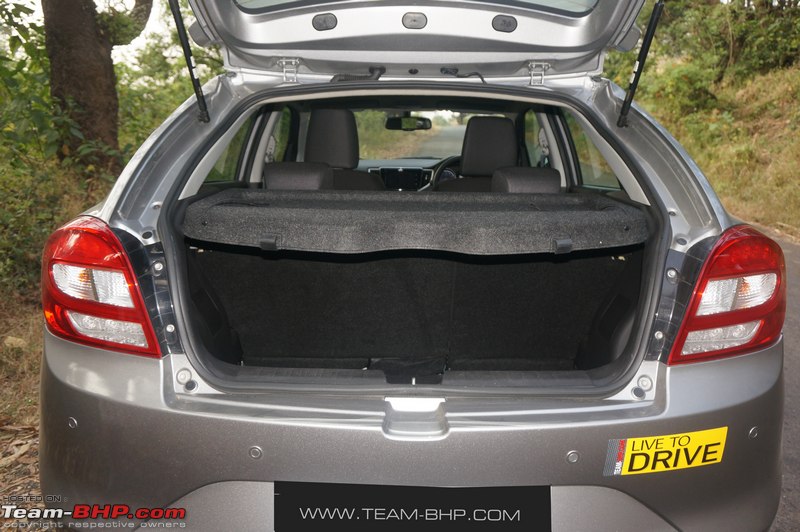 Even with the suspension taking up some place, the boot can accommodate a healthy amount of luggage: 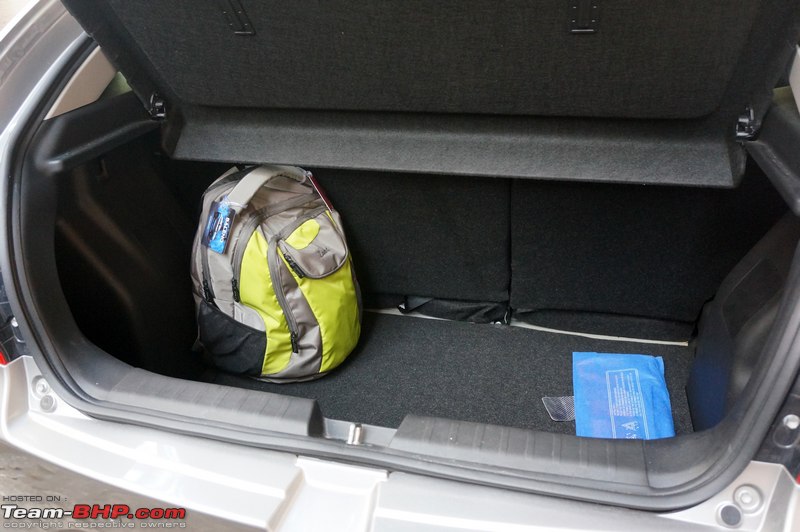 Parcel tray gets a prominent lip along its border to keep things from rolling off:  Rear seats can split in a 60:40 ratio for cargo flexibility. Here also, you can see the sheer height of the boot's loading lip:  With the rear seats folded down. Rear seats don't fold flat like those of the Honda Jazz top variant (image link):  Boot gets a light along with a bag hook on the left:  While export variants get a space saver, the Indian Baleno has a 185/65 R15 steel wheel. Tyre is thinner & wheel is smaller than the top variant's 195/55 R16 rubber. It carries a speed limit of 80 kph, but we're guessing only for the top variant where its size differs from the regular 4 tyres. Even the brand (MRF ZVTV) is different from the regular tyres (Apollo Alnac) on the top variant!  A look at the tools and their packing pouch:  No need to remove the smartkey from your pocket. Simply press this request sensor (on the right) and the release button:  The hatch is held up by pneumatic struts on both sides:  Last edited by GTO : 9th December 2015 at 18:09. |
| |  (53)
Thanks (53)
Thanks
 |
| The following 53 BHPians Thank Aditya for this useful post: | aah78, Added_flavor, aeroamit, blackwasp, Contrapunto, Dr.AD, Dr.Q, fulcrum.xyz, gschandra, GTO, InControl, Karthik Chandra, kashyapz8055, KLxpress, Leoshashi, libranof1987, Maky, Midas, mrbaddy, MSAneesh, noopster, petrolhead_neel, phynix123, R2D2, racer_ash, rajesh1868, RavenAvi, rednikhil, Researcher, rev_rohit, romeomidhun, rshanker, S.MJet, S2!!!, samabhi, samaspire, Scarlet_Rider, sidhu_hs, Simhi, swiftnfurious, Technocrat, theexperthand, Tushar, uday.ere, valapad, vb-saan, vibbs, Vid6639, Viju, Vik0728, vikred, viv_cal, Wildy |
| | #5 |
| Team-BHP Support  | The In-Car Entertainment 7" touchscreen head-unit's interface is now a familiar sight on expensive Marutis. It's divided into four sections. The touchscreen is quite fast, with very little lag, if any. An improvement from what we saw in the first batch of Ciazes:  Music can be played from a variety of sources:  User interface is nice:  Pairing with your smartphone is quick & easy:   Use the preset equalizers or set the sound yourself:  A close look at the door-mounted tweeter:  Rear view camera has colour-coded distance demarcations. Very helpful while parking, especially as the rearward visibility is poor. Reversing camera is effective at night as well:  Terribly annoying. You have to 'confirm' each time before using the navigation system:  The navigation is SD card-based. Maps provided by Nokia HERE:  Straightforward interface allows you to search for a particular location with ease:  POIs include Maruti-Suzuki dealerships & service centers: 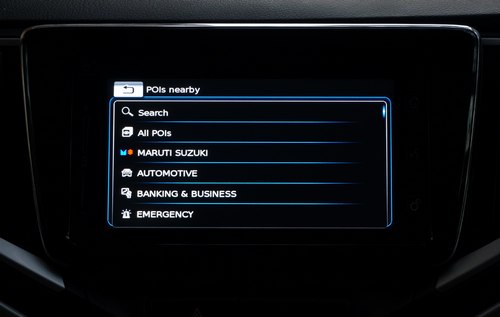 Last edited by GTO : 9th December 2015 at 18:08. |
| |  (46)
Thanks (46)
Thanks
 |
| The following 46 BHPians Thank Aditya for this useful post: | aah78, abhik897, aeroamit, carrazy, Contrapunto, Doge, Dr.AD, Dr.Q, FGFARahul, gschandra, GTO, Karthik Chandra, kashyapz8055, KLxpress, libranof1987, mrbaddy, myavu, noopster, petrolhead_neel, R2D2, racer_ash, rajesh1868, RavenAvi, rednikhil, Researcher, rev_rohit, romeomidhun, rshanker, S.MJet, S2!!!, samabhi, sidhu_hs, Simhi, swiftnfurious, Technocrat, theexperthand, Tushar, uday.ere, valapad, vb-saan, vibbs, Vid6639, Viju, Vik0728, vikred, Wildy |
| | #6 |
| Team-BHP Support  | Driving the 1.2L Petrol MT 1.2 liter K12 engine used in many other Maruti cars. Loads of empty space! The engine bay can easily accommodate a larger motor, but we all know that's not in the pipeline. Notice that the petrol doesn't get an engine cover:  The Baleno is powered by the same 1,197cc, 4-cylinder K12 petrol engine as the Swift, Ritz and Dzire. It produces 83 BHP @ 6,000 rpm and 115 Nm of torque @ 4,000 rpm. This is about the same as the Hyundai Elite i20 but 6 BHP lesser than the Honda Jazz. Nevertheless, with a kerb weight of merely 865 kg, the Baleno has a power-to-weight ratio of 96 BHP / ton which is better than the Hyundai & Honda. Its torque-to-weight ratio of 133 Nm / ton is also superior to the i20 & Jazz. To start the engine, the MID asks you to press the clutch & brake, then hit the engine start / stop button. Still, the Baleno starts with just the clutch pedal depressed. At idle, the engine is very refined. Maruti's 1.2L K-series has always been considered a jewel. The Baleno is the lightest car it's been deployed in. Hence, the engine feels better than it does even in the Swift. The Baleno offers good driveability in the city and the low rpm behaviour is satisfactory (by 1.2L standards). It's likeable and the car does drive better than the Elite i20 1.2L. If there is a fault, it's that the 3rd gear is a little taller than we would have liked, thus there will be situations where you have to downshift to 2nd when the speed drops. Other than that, the engine is competent. Combine that with the light steering, good frontal visibility & spot-on ergonomics and the Baleno makes for a great city commuter. Open road performance is enjoyable. In a straight drag to 100, the Baleno is easily quicker than the i20 & Jazz. Power delivery is also linear in nature. The 1.2L petrol is very revv-happy & remains refined throughout the rpm range; the feel above 4,000 rpm is nice. The engine note at high rpm sounds great to an enthusiast like me (although regular Joes won't like it). Thanks to the Baleno's peppy nature, highway performance is satisfactory. There is a downside though = Maruti has set the max engine rpm to a very conservative ~6,300 rpm. The fuel supply cuts off unexpectedly! This is disappointing as the engine is still pulling well and easily has a couple of hundred revs left. There will be times when you'll (unexpectedly) hit the revv limiter in the middle of an overtaking manouveur, and be forced to upshift. In terms of cruisability, 100 kph is seen at 2,500 rpm in 5th gear. That's more relaxed than the i20's engine which is spinning at 2,750 rpm. The clutch is light and pressing it takes no effort. The gearshift is also smooth to operate, and slotting into the right gear is easy. The Baleno's 21.4 kpl ARAI rating is higher than that of the Swift. Again, it's all down to the light kerb weight. In terms of NVH, Maruti has clearly skimped on insulation materials. Whether this was due to weight or cost saving is anybody's guess, but high rpm engine sound is more than you would expect. Enthusiasts will enjoy it, regular folk won't. As the speedometer climbs, tyre & wind noise start creeping into the cabin too. Both - the petrol and diesel - get an insulation sheet here:  Massive gap between the engine and radiator. There is no underbody protection. You can see the ground below very clearly:  Firewall gets insulation sheet as well. It isn't enough though. The quality of insulation isn't to our satisfaction:  VIN stamped on the left side of the engine bay:  5-speed manual is smooth:  Driving the 1.2L Petrol CVT The CVT gearlever. Black button on the right side engages 'sport' mode. No paddle shifters like the Jazz:  Lots of room in the footwell. Dead pedal to relax your left leg too:  Gear position is prominently displayed on the MID:  I took a spin in the CVT variant as well! Am a bit surprised that Maruti chose a CVT for the Baleno, considering how hard they are pushing the AMT in other hatchbacks. One thing for sure, the CVT is far smoother than the AMT and has none of that jerkiness. Those looking for a convenient city car will be pleased with the Baleno automatic. As with most CVT gearboxes, this one too performs better on part throttle input than full throttle. Keep the pedal inputs light and the Baleno moves seamlessly. As is typical of CVTs, the driving experience is butter smooth. If you are in bumper to bumper traffic, simply take your foot off the brake pedal (without any accelerator input) and the car crawls forward gently. This cuts down on driver effort in stop / go traffic and hence, reduces fatigue. Throttle response at city speeds is good and as long as you are gentle with the accelerator, the CVT is very smooth. However, press the accelerator hard and you’ll feel a jerk. The CVT, excellent front seats & light steering make the Baleno automatic a breeze to drive in the city. On the highway, the CVT is not impressive. That infamous rubber band effect is felt when you drive hard. Stomp on the A pedal and the engine revvs to 6,000 rpm, but the speed of the car increases very slowly (while the engine is screaming its lungs out). There's a lot of noise and no progress. The weakness of CVT gearboxes is most evident with small engines and it's no different here (just like what we saw with the Jazz 1.2L CVT). What's more, accelerate hard, leave the throttle, then press it again and you'll see a delay before the power comes in. The CVT's performance can be frustrating on a fast expressway. Most owners will just prefer to move to the middle lane, leave any pretensions of urgency behind and cruise calmly. This gearbox hates to be overworked. Overtaking manoeuvres also need to be planned carefully. The CVT does offer a sport mode. Engaging it gets you a slightly better response to throttle inputs and the speed builds up a little quicker. Perhaps better for the highway, but let me make one thing clear = it's far from "sporty". In summary, the CVT is most suited to point A -> B urban commuting with gradual inputs from the driver. If you are a sedate driver, you can manage on the highway too. But the competition - in particular the Polo GT TSI & Figo 1.5L DCT - are way more competent. The CVT's ARAI rating of 21.4 kpl is identical to its petrol sibling. Maruti supplies the CVT only on the Delta (second from base) trim level. Maybe, a more equipped automatic variant will follow later. Driving the 1.3L Diesel Familiar 1.3L diesel running the mass market state of tune. Diesel gets an engine cover (unlike the petrol):  The Baleno uses the 1,248cc, 4-cylinder diesel engine found in so many cars that we've named it 'the national engine of India'. The DDiS 190, as Maruti prefers to call it, has a fixed geometry turbocharger and produces 74 BHP @ 4,000 rpm and peak torque of 190 Nm @ 2,000 rpm. The Baleno's competitors such as the Hyundai Elite i20 and Honda Jazz use larger capacity diesels that make 89 BHP / 220 Nm and 99 BHP / 200 Nm of torque respectively. We were expecting Maruti to deploy the 89 BHP VGT version of this engine. Alas, that isn't the case, possibly to differentiate the more expensive S-Cross 1.3L from the Baleno. Again, thanks to the Baleno's lighter kerb weight, it has a power to weight ratio of 77 BHP / ton which is comparable to the Elite i20. The Honda Jazz with 88 BHP / ton leads the pack by a long way though. Just for reference, the Swift has a power to weight ratio of 70 BHP / ton. Hit the engine start button and a familiar clatter greets you. Yep, the noise insulation isn't as good as it should be in a contemporary hatchback. This is felt more in the diesel than the petrol. The diesel moves off the blocks effortlessly. The Baleno is lighter than the Swift, thus it feels a little more peppy. There is some turbo lag below 2,000 rpm, yet Maruti has tuned it in a manner that one can live with it, especially in the lower gears. This makes the engine acceptable in the city. It’s only when you need to close gaps quickly or when the rpm needle drops too low that you'll need to downshift. No doubt, cars like the Jazz & Figo 1.5 offer superior driveability with their zero-lag power plants. Cross 2,000 rpm and you can feel the turbo's boost, but it's not a major rush. While the Baleno petrol is quicker than its competitors, the Elite i20 & Jazz are faster when it comes to the diesels. No, it's no slouch, but neither is the Baleno 1.3L a road burner. Open road performance is par for the course and the diesel engine offers a good mid-range. Push it and she'll revv to 5,400 rpm (though it's best to upshift earlier). Work the engine and you can make decent progress on the highway. The Baleno diesel can be a relaxed cruiser as well - 100 kph is seen at 2,100 rpm. At this point, the engine is in 'turbo' zone, hence you don't need to downshift to make an expressway pass. The clutch is light enough, the gearbox is smooth to operate and its gates are well defined. No complaints on this front. What owners will dislike though is Maruti skimping on NVH materials. I reiterate, the diesel's clatter & high rpm sound are more audible than what you'd expect in a modern hatchback. In comparison, the i20 offers refinement that is at least 2 levels better. No contest. The Baleno diesel's ARAI rating is a whopping 27.39 kpl. We have no doubt that owners will find its fuel economy to be very endearing. Equally, we must add that the Elite i20 & Jazz offer diesel engines that are better to drive (in the city and on the open road). Ride, Handling, Steering & Braking The Baleno has a good suspension tune for a family hatchback. To start with, ride quality is very pliant. At low speeds, the cabin is comfortable, not jiggly or bumpy. The suspension is silent as well with no annoying sounds produced on bad roads. Owners will enjoy the comfort levels. At highway speeds, the Baleno just glides over rough patches and road irregularities. Of course, large & sharp bumps do permeate through the cabin. This is more so in the top variant with 16" rims. The lower variants with 15" wheels & taller sidewalls should offer an even better ride. Since the last 4 years, we've seen Maruti engineers increasingly focus on ride comfort and the Baleno is no different. In terms of handling, the grip levels are safe & predictable. The Baleno isn't as tight or fun to drive as the smaller Swift, yet its overall dynamics are sorted and there are no nasty surprises. It's clean and behaves as intended. The fact that the Baleno is adequately tyred (not usually the case for a Maruti hatchback) with 195/55 R16 rubber makes a BIG difference. I flung the car into corners at speed and she managed to hold the intended line. Push hard and you will feel the body roll, with understeer coming in gradually as you approach the limit. No, it's not razor sharp or a corner carving tool, but for a family hatchback, the dynamics are very neutral. We had our concerns on high speed stability due to the lightweight nature of the car. Rest assured, the Baleno can cruise at 120 kph all day. The car (surprisingly) doesn't feel nervous at this speed. Not rock solid like the Europeans, yet satisfactory by Japanese car standards. That said, strong crosswinds do affect the car's stability on the highway. The Baleno's electric power steering is very light while parking, and at low speeds. This makes it a delight in the city. The steering is fairly direct as well! As the speedometer climbs, the EPS weighs up adequately (but is never 'heavy'). Additionally, the Baleno's turning radius of 4.9 meters will make those U-turns easier than the Jazz (5.1 m) & Elite i20 (5.2 m). Ground clearance is rated at 170 mm. That's pretty much the segment standard, with most competitors offering similar levels of clearance. On the flip side, we noticed that the rear of the Baleno does sag considerably when the back seat is filled up with passengers. This is a cause for concern. We'll leave final verdict to our ownership reports. Stopping power comes from typically Maruti brakes. Translated, they do the job, but are nothing to write home about. I did find the brake pedal to be spongy and wish that it provided more initial bite. ABS is standard on all variants of the Baleno. This is a welcome move as the non-ABS variants of the Swift & Dzire are known for their poor braking ability. Last edited by GTO : 10th December 2015 at 16:40. |
| |  (75)
Thanks (75)
Thanks
 |
| The following 75 BHPians Thank Aditya for this useful post: | 9thsphinx, aah78, abhik897, aeroamit, Aficionados, agm, amit_purohit20, Aragorn, aravindkumarp, arjab, autospeaker, Balaji31582, blackwasp, Contrapunto, Doge, dr. sen, Dr.AD, Dr.Q, engine_charan, FGFARahul, fulcrum.xyz, Grand Drive, greenwolf08, gschandra, GTO, hardyk2010, iamswift, InControl, Karthik Chandra, kashyapz8055, KLxpress, Leoshashi, libranof1987, Luv_Jaiswal, Mahesh Prasad, mrbaddy, MSAneesh, Musa, NirmalK, noopster, paragsachania, petrolhead_neel, rajesh1868, RavenAvi, rednikhil, Researcher, riturajsharma19, rshanker, RWD, S.MJet, S2!!!, samabhi, Scarlet_Rider, SchumiFan, sdp1975, shipnil, siddarthab, sidhu_hs, Simhi, supremoo, swiftnfurious, Technocrat, theexperthand, Tushar, uday.ere, vaasu, valapad, vb-saan, vibbs, Vid6639, VijayAnand1, Vik0728, vikred, vinit.merchant, viv_cal |
| | #7 |
| Team-BHP Support  | Other Points: • Team-BHP was the first to show you the YRA / Baleno in India  - link to Anshuman's scoop thread! - link to Anshuman's scoop thread!• The Baleno's sales performance is all the more impressive when you consider that it's being sold through Nexa outlets only. These are limited in reach and simply cannot match Maruti's main dealership network. • In the city, watch the width. This is a wide hatchback and it'll take you sometime to get the right 'judgement'. Light weight makes it very agile; despite the size, you can chuck it around with ease. • This platform will be used for future Marutis, including the next-generation Swift (and thus, the Dzire & Ertiga). • Available in 7 colours - Solid Fire Red, Premium Urban Blue, Metallic Premium Silver, Autumn Orange, Ray Blue, Pearl Arctic White and Granite Grey. No black  . .• The MT variants are sold in 4 trim levels - Sigma, Delta, Zeta and Alpha. The CVT is available in Delta only. • If you buy the top variant, you don't need to upgrade the tyres. If you buy the lower variants with 185 mm tyres and are looking to upgrade, this thread is for you. • ABS, dual airbags and front seatbelts with pre-tensioners + force limiters are standard on all Baleno variants. A great move. Could also be due to marketing considerations as the equipment helps negate the 'safety concerns' created by its light weight. We're talking about mass market perception levels here. • Good news is, on the variants without the engine start button, there's no ugly plastic cap reminding you of what you're missing. Thanks to BHPian HolyDriver for sharing this picture. • Standard warranty of 2 years / 40,000 kms. Extended warranty for up to 4 years / 80,000 kms can be purchased. • Service interval of 10,000 km / 1 year. There are two basic inspections at the 1,000 km / 1 month & 5,000 km / 6 months mark at the start. • All variants - except the base - get 60:40 splitting rear seats. • Happy to see that useful features like the rear wash / wipe / defogger are available on all variants, other than the base. The Elite i20 gets rear wash & wipe only on the top Asta variant. • In international markets, the Baleno gets a 1.0L, 3-cylinder Boosterjet turbocharged petrol engine with direct injection. It makes 109 BHP & 170 Nm of torque!! We'll definitely see this engine here sometime in the future. • Baleno is equipped with 'follow me home' and 'lead me to vehicle' lights. • Disclaimer: Maruti invited Team-BHP for the Baleno test-drive. They covered all the travel expenses for this driving event. • Watch Gadget Wala's video to see the Apple Car Play in action: Last edited by GTO : 9th December 2015 at 18:58. |
| |  (57)
Thanks (57)
Thanks
 |
| The following 57 BHPians Thank Aditya for this useful post: | aah78, abhik897, aeroamit, blackwasp, carrazy, Contrapunto, Doge, dr. sen, Dr.AD, Dr.Q, FGFARahul, fulcrum.xyz, GTO, hardyk2010, hershlulla, InControl, Karthik Chandra, kashyapz8055, KLxpress, libranof1987, LordSharan, mrbaddy, MSAneesh, nkghai, Paavan Shetty, petrolhead_neel, phynix123, pulsar56, racer_ash, Rajeevraj, rajesh1868, RavenAvi, RedDevil_KP, Researcher, romeomidhun, rshanker, S.MJet, S2!!!, samabhi, Scarlet_Rider, siddarthab, sidhu_hs, sidparekh, Simhi, swiftnfurious, Technocrat, theexperthand, Tushar, uday.ere, valapad, vb-saan, VeluM, vibbs, Vid6639, Vik0728, viv_cal, yousivakutti |
| | #8 |
| Team-BHP Support  | The Smaller yet Significant Things: The Baleno comes with 'UV Cut Glasses' which Maruti claims cut UV rays by up to 85%. To their credit, I didn't feel the sun sting my right arm while driving around the city on a hot day. UV cut glass provided on the side windows & quarter glasses. In this sunfilm-less era, such solutions from the factory are a godsend. We hope other manufacturers follow suit:  Footwells get red ambient lighting:  Link to the Baleno's official accessory area. Thanks to BHPian abhik897 for sharing the prices here:  The smartkey:  OBD port is located below the dashboard (on the right):  A cubicle above the bonnet release:  The side vents get silver surrounds and air volume control which isn't smooth - required some effort to operate:  No air volume control for the center vents:  Rear seat gets hooks to park the seatbelt:  Climate control buttons are lit up in orange when the parking lights are turned on:  IRVM gets the 'auto-dimming' feature. Its visibility is hampered by the small rear windshield, thick C pillars and large rear headrests:  MID shows the exact door that is open:  Handbrake has a very short travel range. This is about as high as it goes:  Floor mats are secured in dedicated slots. Notice the Hindi warning label, a rare sight on cars in India:  DDiS badges on both front panels distinguish the diesel Baleno from the petrol (petrol gets no badging):  The fuel flap release peeps out from a small hole in the floor mat. No boot release accompanying it. The hatch locks / unlocks with the central locking system:  A "Diesel Only" sticker on the fuel flap to warn the pump attendant:  Petrol Baleno doesn't get any sticker. Be sure to monitor yourself what's going into her belly:  A black plastic spill protector is provided:  Yep, the ORVMs are India-friendly!  Rubber beading doesn't feel premium (hello Nexa?). After fixing it properly, it would again start sagging in a short while:  Puddle lamps ensure that you don't step on an undesirable surface:  Metal sticker with VIN & engine numbers riveted on the driver's door frame:  29 PSI all around:  Nexa showroom before the Baleno (thanks to BHPian volkman10 for these pics). Salesmen outnumber customers:  After the Baleno. More customers, less salesmen: 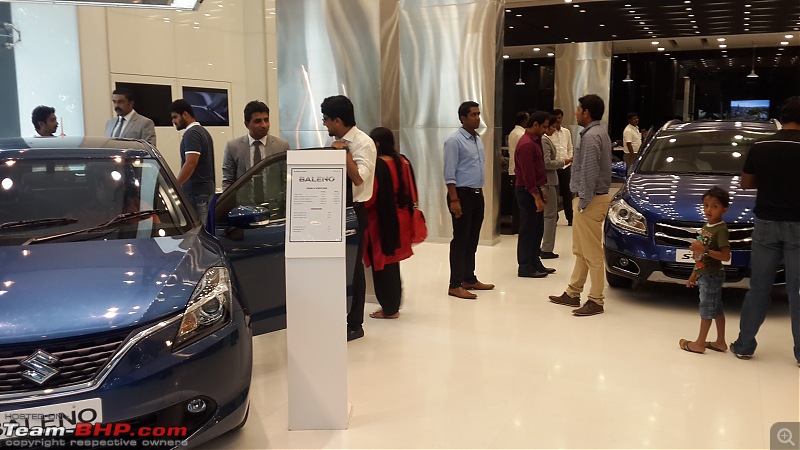 Last edited by GTO : 9th December 2015 at 18:05. |
| |  (62)
Thanks (62)
Thanks
 |
| The following 62 BHPians Thank Aditya for this useful post: | aah78, abhik897, Added_flavor, aeroamit, Aragorn, aravindkumarp, arif_iq, carrazy, Contrapunto, Dr.AD, Dr.Q, droolingvoyager, eddy481, FGFARahul, fulcrum.xyz, fusionbang, GTO, hardyk2010, hershlulla, InControl, Karthik Chandra, kashyapz8055, KLxpress, Leoshashi, Maky, mallumowgli, mrbaddy, MSAneesh, petrolhead_neel, phynix123, Piyadassi, racer_ash, Rajeevraj, rajesh1868, RavenAvi, rednikhil, Researcher, romeomidhun, rshanker, S.MJet, S2!!!, samabhi, Scarlet_Rider, shipnil, siddarthab, sidhu_hs, Simhi, Stratos, swiftnfurious, Technocrat, theexperthand, Thunder70, Tushar, uday.ere, valapad, vb-saan, vibbs, Vid6639, Vik0728, viren83, viv_cal, Wildy |
| | #9 |
| Team-BHP Support  | Chief Competitors of the Maruti Baleno What you'll like: • All-rounded package in a sharp design. Improved over the 1st-gen i20 in nearly every way • Spacious interiors with outstanding quality, fit and finish. Practical 285 liter boot too • 1.4L diesel has excellent driveability, refinement, performance & fuel economy. 6-speed gearbox is smooth • Mature suspension offers a comfortable ride and neutral handling characteristics • Hyundai's fuss-free ownership experience & excellent after-sales-service • Loaded with features & gizmos (16" rims, keyless entry & go, 8-speaker stereo, rake & reach steering, rear air-con, reversing cam, cooled glovebox and lots more) What you won't: • Missing equipment vis-a-vis old i20: Rear disc brakes, side & curtain airbags, sunroof, auto-wipers & DRLs • 1.2L petrol is nowhere as impressive as the diesel. Mediocre highway performance for a premium hatchback • Anyone over 5'11" will find rear headroom to be insufficient. Sloping roof eats into cabin height at the back • Dynamics & steering aren't to an enthusiast's tastes. Swift, Polo etc. are more fun to drive • On-road price difference between the petrol & diesel is ~1.3 lakhs. That's higher than the competition • Rear wiper only on the top Asta trim! No fuel-efficiency indicator, auto-locking doors or height-adjustable seatbelts on any variant What you'll like: • Versatile package wearing sharp clothes. One car for several roles • Spacious, user-friendly cabin. Easily the roomiest hatchback in India • Big 354 liter boot is the segment best. Magic seats bring tons of flexibility • Practical & efficient diesel, refined & revv-happy petrol and a convenient CVT. Take your pick • Comfortable ride quality. Much improved over the older Jazz • Light controls and easy maneuverability. Effortless to drive in the city • Features such as feather-touch climate control, reversing camera, touchscreen ICE, paddle shifters (CVT) & more What you won't: • Loud diesel engine is nowhere as refined as the Elite i20's. Doesn't like high rpms either • 1.2L petrol has a weak bottom end. Feels lethargic <2,500 rpm • On-road premium for diesel is Rs. 1.3 - 1.5 lakhs! That's higher than the competition • Magic seats only on the top variant (earlier Jazz had them on all trim levels) • CVT unavailable with the VX trim! No fully loaded Automatic • Skinny 175 mm tyres. All competitors offer thicker rubber (Elite i20 = 195 mm) • Missing goodies (steering reach adjustment, keyless entry & go, rear air-con vents, driver armrest & proper dead pedal) What you'll like: • Aston Martin-esque face looks very stylish! • Value for money positioning. Priced lower than the Swift • Powerful & efficient 1.5L diesel engine. Good driveability too • Compliant ride quality. Suspension is tuned for comfort • Airbags across the range. Titanium+ variant gets 6 airbags! • Well-packaged cabin offers good legroom, lots of features and a chilling air-con • Dual-clutch Automatic with a bigger 1.5L petrol, ESP, traction control & hill start assist What you won't: • Commuter 1.2L petrol is unimpressive. A mediocre engine • Ordinary handling and lighter build quality are a departure from the usual Ford characteristics • Cabin width makes the Figo suited to 4 adults, not 5 • 14" rims look too puny. Tyres could be wider, especially for the fast diesel • Rear headroom is limited. Headliner brushes the heads of taller passengers • Automatic unavailable in the fully-loaded trim • At highway speeds, downshifts aren't as immediate as you'd expect from a dual-clutch automatic What you'll like: • A well-built solid European hatchback • 1.5L diesel & 1.2L TSI petrol engines are very competent • Clean and contemporary styling. Absolutely no quirkiness • Mature suspension offers a balanced ride & handling package • Dual airbags even in the base variants! • Accommodating 280 liter boot What you won't: • Base 3-cylinder 1.2L petrol engine is unimpressive • Mediocre rear bench legroom and a large floor hump • Missing essentials (driver armrest of the Vento, 60:40 splitting rear seat, seatback pockets) • VW's sub-par dealership & service experiences What you'll like: • Build quality, fit and finish are on par with competitors. Tata has made significant improvements here • Spacious well-designed interiors. A rare hatchback that can seat 5 adults without a fuss • Competent 1.2L turbo-petrol & 1.3L diesel. Both offer good driveability • Balanced suspension offers safe & neutral handling. Nice EPS too • Light controls & agreeable ergonomics. Drives like no Tata hatchback has before • Superb 8-speaker Harman Kardon entertainment system with navigation & video playback • Features: 3-driving modes (Eco, Sport, City), projector headlamps, 5" touchscreen, voice commands etc. What you won't: • Neither engine offers strong outright performance. Both are commuter motors, nothing else • Impractical 210 liter boot is among the smallest from this segment • Pricing of some variants is too close to the Zest (Bolt XT vs Zest XT diesel = merely 31k) • Ride quality is firmer than the Zest. Noise insulation not as tight as its sibling either • AMT (automatic gearbox) & higher-tune 89 BHP diesel not on offer. Might follow later • Poor in-cabin storage & missing niceties (Zest's DRLs & parking sensors, dead pedal, height adjustable seatbelts) • Concerns over long-term reliability. Also, Tata's sub-par after-sales service is far from that of Maruti & Hyundai What you'll like: • A neutral family hatchback with the "T" badge • Spacious interiors can easily carry 5 adults • Super light controls, especially steering & short-throw clutch. Effortless to drive within the city • Well-tuned suspension. Safe handling and flat ride • Airbags, ABS & EBD available across the range • Toyota’s fuss-free ownership experience & excellent after-sales What you won't: • 1.2L petrol lacks bottom end. Diesel has merely 67 BHP on tap • Cost-cutting glaringly obvious in many areas • Economy-grade interior quality & unconventional dashboard • Missing equipment (climate control, height adjustable driver's seat etc.) • Poor insulation. Engine, suspension & road noise are prominent Maruti Swift 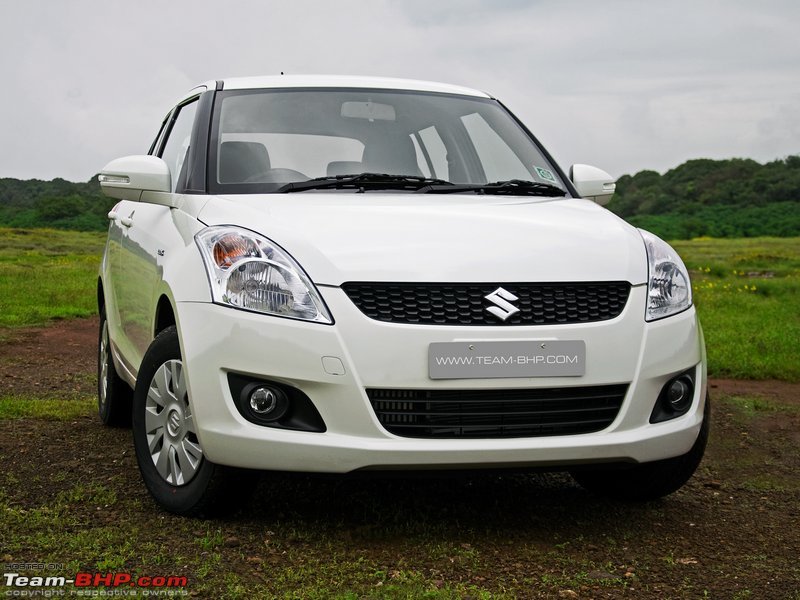 What you'll like: • Snazzy styling packs appeal. Interiors are well-designed too • Competent engine range. Very refined motors • Balanced ride and handling. Superbly tuned suspension • Terrific fuel efficiency, especially from the diesel • Effortless to drive in the city; lots of fun on the highway • Maruti’s excellent after-sales service & wide dealer network What you won't: • Small, impractical boot. Luggage capacity is severely restricted • Mediocre brakes (lower non-ABS variants). Inadequate for emergency braking conditions • Looks nearly identical to the outgoing generation car • Rear seat space, though improved, still isn't "spacious" • Pricey ZXi / ZDi variants Last edited by GTO : 10th December 2015 at 17:24. |
| |  (55)
Thanks (55)
Thanks
 |
| The following 55 BHPians Thank Aditya for this useful post: | 9thsphinx, abhik897, aeroamit, Aficionados, agm, Contrapunto, digitalSpeed, dr. sen, Dr.Naren, Dr.Q, fulcrum.xyz, GetLife, gostel, GTO, InControl, Karthik Chandra, kashyapz8055, Keynote, Kings_Wit, KLxpress, libranof1987, LordSharan, motorpsycho, mp417, mrbaddy, Nagesh Bhatt, Paavan Shetty, racer_ash, Ranga, RavenAvi, Researcher, romeomidhun, RWD, S.MJet, S2!!!, sameer sultan, Scarlet_Rider, shreyascashyap, sidhu_hs, sidzz, snaseer, swiftnfurious, theexperthand, thoma, turbospooler, Tushar, uday.ere, vb-saan, VeluM, vibbs, Vid6639, viren83, viv_cal, Whichcarnow, Wildy |
| | #10 |
| Team-BHP Support  | Re: Maruti Baleno : Official Review Thread moved from the Assembly Line to Official Reviews. Thanks for sharing! The Baleno surprised / shocked me in two ways: 1. The price. As you rightly said, I thought it's going to end up in no man's land, what with all the Nexa + premium talk happening. On the day of the launch, when I saw how close it's positioned to the Swift, I was shocked. Hats off to Maruti for the sheer VFM pricing. The difference from the Swift is nothing in EMI terms - I can't see any reason why one would buy a Swift (or even the Dzire) over the Baleno. 2. Second pleasant surprise was the car itself. I took it all around Bombay at night and my mind went 'damn, this car is competent'. First the S-Cross 1.6, and now the Baleno. Maruti is making better hatchbacks than it ever has before. Suzuki's engineering strength has grown by leaps & bounds in the last 5 years. Indeed, the Baleno is an all-rounder. That said, the Hyundai i20 remains the segment benchmark. The difference between the top-end Baleno & Elite i20 is less than Rs. 20,000 (basically...nothing). My pick would be the Elite i20 any which day - it feels a lot more substantial, offers the interior quality of cars priced twice or thrice as much, is far more refined and the diesel (my choice) is a superior engine. No contest. But I am surprised by how close Maruti has come. These are the two big hatchbacks to beat in the market today. In their own way, they have moved the game ahead. Cars like the Polo, Liva, Bolt etc. will only suffer more. And whatever future hatchbacks are coming our way in 2016, they are going to have to improve their offering. I can sense product managers of other companies breaking into a sweat. For us customers, cars like the Elite i20 & Baleno make the entire segment better. God bless competition  . .Last edited by GTO : 9th December 2015 at 18:32. |
| |  (81)
Thanks (81)
Thanks
 |
| The following 81 BHPians Thank GTO for this useful post: | 9thsphinx, a4anurag, abhik897, aeroamit, Aficionados, amit_2025, amit_purohit20, aravindkumarp, Arjan, arnabchak, carrazy, Contrapunto, dr. sen, Dr.AD, Dr.Naren, Dr.Q, eddy481, Grand Drive, grevvity, hardyk2010, InControl, jvm_1986, kashyapz8055, Keynote, KLxpress, Leoshashi, maverick.munish, mayank0782, Mohd Faiz, mrbaddy, Nagesh Bhatt, nmenon, Paavan Shetty, paragsachania, PearlJam, petrolhead_neel, phynix123, pmbabu, psankar, racer_ash, Rajeevraj, rajesh1868, Ranga, RavenAvi, rednikhil, Reinhard, Researcher, RiverRanger, romeomidhun, S2!!!, Safari_Beast, samabhi, sandeepmohan, Santoshbhat, Scarlet_Rider, sdp1975, shreyascashyap, siddarthab, sidhu_hs, snaseer, Stratos, suhaas307, super.cars, swiftdiesel, swiftnfurious, Technocrat, theexperthand, thoma, turbospooler, uday.ere, vb-saan, VeluM, venki.bala, vibbs, Vid6639, Vik0728, vikred, viren83, viv_cal, vsrivatsa, Whichcarnow |
| | #11 |
| BHPian Join Date: Sep 2014 Location: Bangalore
Posts: 62
Thanked: 75 Times
| Re: Maruti Baleno : Official Review Finally!!! The much awaited review is here. Heartfelt thank-you for such a detailed review. Maruti Suzuki has proved that it is not far behind from great, beautiful designs. |
| |  (2)
Thanks (2)
Thanks
 |
| The following 2 BHPians Thank Crazy_cars_guy for this useful post: | ankurvirmani19, Contrapunto |
| |
| | #12 |
| BHPian Join Date: Nov 2015 Location: Trivandrum
Posts: 88
Thanked: 59 Times
| Re: Maruti Baleno : Official Review And finally a T-BHP review! Amazing review Aditya sir (as always)! The details and images are just mind-blowing! Keep it up. Another 5 star rating thread. I am sure the Baleno will be a hit (already seeing a ton of them). Maruti has packed almost all the features that a car owner was updated be looking for and combine that with the "Maruti Suzuki" brand name is just awesome. Maruti is finally looking up to the safety aspect and is giving the airbags and ABS on the base model too. Kudos to them! |
| |  (1)
Thanks (1)
Thanks
 |
| The following BHPian Thanks The Dude for this useful post: | Contrapunto |
| | #13 |
| BHPian Join Date: Apr 2009 Location: London
Posts: 621
Thanked: 1,010 Times
| Re: Maruti Baleno : Official Review Finally Finally the most awaited review is out of the box  Again an excellent review and default 5 star rating. This is one car I have been waiting for long and serious contemplating to buy next year. I am also glad that Maruti has finally taken a serious view of Safety and provided ABS and Airbags as standard. Regards |
| |  (2)
Thanks (2)
Thanks
 |
| The following 2 BHPians Thank chandrda for this useful post: | Contrapunto, Leoshashi |
| | #14 |
| BHPian Join Date: Jun 2015 Location: Gurgaon
Posts: 84
Thanked: 147 Times
| Re: Maruti Baleno : Official Review The Baleno didnt look to good to me when i first saw the pics, its only after i read this review do i feel that this is one competent hatchback. My personal favourite is the elite i20 and ever since i have been a passenger in it (my cousin has it) I have been amazed by it. The interior quality is really close to our X3 which only wins because of the soft touch materials in the interior otherwise i felt the plastic quality in both the cars was more or less the same. I think the two places where the Baleno really dissapoints is the build quality and the diesel engine and both these factors might push buyers to consoder the i20 more seriously than the Baleno. The interior quality too is nothing to write about. Unfortunately even their premium hatchback doesnt feel so premium. For me its the i20 all day long. |
| |  (3)
Thanks (3)
Thanks
 |
| The following 3 BHPians Thank CarLoverJosh for this useful post: | Contrapunto, jetti, swiftdiesel |
| | #15 |
| Distinguished - BHPian  Join Date: Aug 2011 Location: Bangalore
Posts: 4,606
Thanked: 17,684 Times
| Lovely review. Thank you. It is quite amazing as to how the official review brings out a fresh perspective in spite of all the pages and pages of discussion that has happened before. Eagerly awaiting the boosterjet. 109hp and 170nm are pretty much polo tsi numbers. And with that low kerb weight, the power to weight ratio will be quite a bit ahead of the tsi. If the boosterjet performance is anywhere close to the VW tsi, Fiat T jet or at least the Ecoboost, we have a good candidate for a well priced, mass market semi hot hatch. On the down side with 9000 copies already from a limited network, I assume Maruti would be in no hurry to bring it in. The build quality is a little worrisome though. Edit: Big kudos for the standard safety features. Hyundai is the only company behind in this. Hope this forces them to make abs and airbags standard on the elite i20 Last edited by Rajeevraj : 9th December 2015 at 19:08. |
| |  (4)
Thanks (4)
Thanks
 |
| The following 4 BHPians Thank Rajeevraj for this useful post: | CarLoverJosh, Contrapunto, rednikhil, Whichcarnow |
 |


